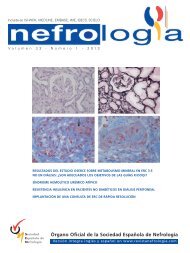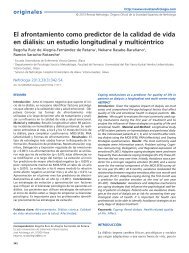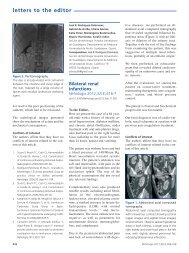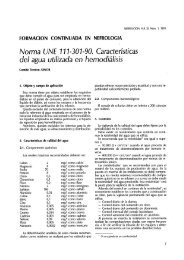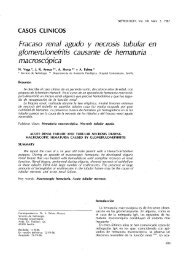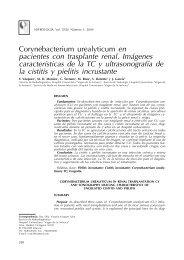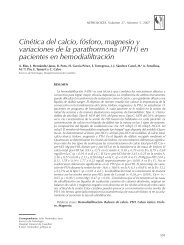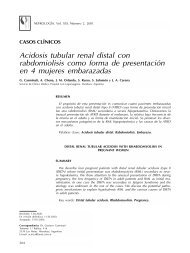PDF Número - NefrologÃa
PDF Número - NefrologÃa
PDF Número - NefrologÃa
You also want an ePaper? Increase the reach of your titles
YUMPU automatically turns print PDFs into web optimized ePapers that Google loves.
evisiones cortas<br />
G.M. London. Arterial calcification<br />
disorders, such as metabolic syndrome, diabetes or CKD.<br />
Media calcification is concentric, not extending into arterial<br />
lumen in its typical pure form and is associated with abnormal<br />
cushioning function of blood vessels (arteriosclerosis-arterial<br />
hardening) by promoting arterial stiffness 34 . The principal<br />
consequences of arterial stiffening are an abnormal arterial<br />
pressure wave (characterized by increased systolic and<br />
decreased diastolic pressures, resulting in high pulse pressure)<br />
and increased aortic characteristic impedance, a measure of<br />
the opposition of the aorta to oscillatory input (i.e., stroke<br />
volume) 35 . Because the two forms of AC are frequently<br />
associated the conduit and cushioning abnormalities could be<br />
associated.<br />
MANAGEMENT AND PREVENTION<br />
AC rarely regress, therefore, the primary goals are<br />
prevention and stabilization of existing calcifications.<br />
Because intimal AC are related to atherosclerosis, the<br />
general approach is non-specific as advocated for patients<br />
with atherosclerosis: control of blood lipids (but no<br />
evidence of a benefit with statins), use of aspirin, treatment<br />
of obesity and hypertension, physical activity, smoking<br />
cessation, and control of diabetes. More specific preventive<br />
measures for patients with CKD or ESRD include<br />
controlling serum calcium and phosphate levels, thereby<br />
avoiding oversuppression of parathyroid activity and ABD 36 .<br />
Disturbances in calcium and phosphate metabolism are<br />
associated with uremic bone disease, and the results of<br />
several studies indicated that calcium overload is associated<br />
with AC development and progression, suggesting that the<br />
overuse of high doses of calcium-based phosphate binders,<br />
pharmacological doses of vitamin D, and high calcium<br />
concentration in the dialysate should be avoided 36-39 . Those<br />
data suggest that the use of calcium-containing phosphate<br />
binders, high intradialytic calcium load, and overuse of<br />
active vitamin D should be avoided in elderly patients and<br />
in those who already have AC.<br />
Conflicts of interest<br />
The authors declare they have no potential conflicts of<br />
interest.<br />
REFERENCES<br />
1. Lindner A, Chara M, Sherrard D, Scribner BM. Accelerated<br />
atherosclerosis in prolonged maintenance hemodialysis. N Engl J<br />
Med 1974;290:697-702.<br />
2. London GM, Drüeke TB. Atherosclerosis and arteriosclerosis in<br />
chronic renal failure. Kidney Int 1997;51:1678-95.<br />
3. Pannier B, Guérin AP, Marchais SJ. Arterial structure and function in<br />
end-stage renal disease. Artery Research 2007;1:79-88.<br />
646<br />
4. Braun J, Oldendorf M, Moshage W. Electron beam computed<br />
tomography in the evaluation of cardiac calcifications in chronic<br />
dialysis patients. Am J Kidney Dis 1996;27:394-401.<br />
5. Goodman WG, Goldin J, Kuizon BD Coronary artery calcification in<br />
young adults with end-stage renal disease who are undergoing<br />
dialysis. N Engl J Med 2000;342:1478-83.<br />
6. Guérin AP, London GM, Marchais SJ, Métivier F. Arterial stiffening<br />
and vascular calcifications in end-stage renal disease. Nephrol Dial<br />
Transplant 2000;15:1014-21.<br />
7. Wilson PWF, Kauppila LI, O’Donnell CJ. Abdominal aortic calcific<br />
deposits are an important predictor of vascular morbidity and<br />
mortality. Circulation 2001;103:1529-34.<br />
8. Keelan PC, Bielak LF, Ashai K. Long-term prognostic value of<br />
coronary calcification detected by electron-beam computed<br />
tomography in patients undergoing coronary angiography.<br />
Circulation 2001;104:412-7.<br />
9. London GM, Guérin AP, Marchais SJ. Arterial media calcification in<br />
end-stage renal disease: impact on all-cause and cardiovascular<br />
mortality. Nephrol Dial Transplant 2003;18:1731-40.<br />
10. Amann K. Media calcification and intima calcification are distinct<br />
entities in chronic kidney disease. Clin J Am Soc Nephrol<br />
2008;3:1599-605.<br />
11. Wang AY, Wang M, Woo J. Cardiac valve calcification as an<br />
important predictor for all-cause mortality and cardiovascular<br />
mortality in long-term peritoneal dialysis patients: a prospective<br />
study. J Am Soc Nephrol 2003;14:159-68.<br />
12. Hayden MR, Tyagi SC, Kolb L. Vascular ossification-calcification in<br />
metabolic syndrome, type 2 diabetes mellitus, chronic kidney<br />
disease, and calciphylaxis-calcific uremic arteriolopathy: the<br />
emerging rolo of sodium thiosulfate. Cardiovasc Diabetol 2005;4:4.<br />
13. Schoppet M, Shroff RC, Hofbauer LC, Shanahan CM. Exploring<br />
the biology of vascular calcification in chronic kidney disease:<br />
what’s circulating? Kidney Int 2008;73:384-90.<br />
14. Demer LL, Tintut Y. Vascular calcification: pathobiology of<br />
multifaceted disease. Circulation 2008;117:2938-48.<br />
15. Reynolds JL, Joannides AJ, Skepper JN. Human Vascular smooth<br />
muscle cells undergo vesicle-mediated calcification in response to<br />
changes in extracellular calcium and phosphate concentrations: a<br />
potential mechanism for accelerated vascular calcification in ESRD.<br />
J Am Soc Nephrol 2004;15:2857-67.<br />
16. Steitz SA, Speer ME, Curinga G. Smooth muscle cell phenotypic<br />
transition associated with calcification. Upregulation of Cbfa1 and<br />
downregulation of smooth muscle lineage markers. Circ Res<br />
2001;89:1147-54.<br />
17. Shao J-S, Cheng SL, Sadhu J, Towler DA. Inflammation and the<br />
osteogenic regulation of vascular calcification. A review and<br />
perspective. Hypertension 2010;55:579-92.<br />
18. Parhami F, Morrow AD, Balucan J. Lipid oxidation products have<br />
opposite effects on calcifying vascular cell and bone cell<br />
differenciation: a possible explanation for the paradox of arterial<br />
calcification in osteoporosis patients. Arterioscler Thromb Vasc Biol<br />
1997;17:680-7.<br />
19. Mody N, Parhami F, Sarafian TA, Demer LL. Oxidative stress<br />
modulates osteoblastic differentiation of vascular and bone cells.<br />
Free Radic Biol Med 2001;31:509-19.<br />
20. Wang TJ, Larson MG, Levy D. C-Reactive protein is associated with<br />
Nefrologia 2011;31(6):644-7



